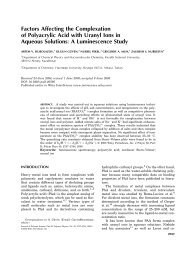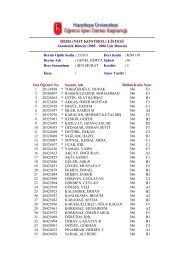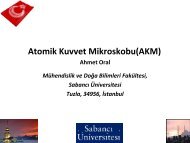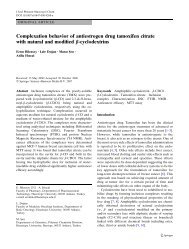Radiation synthesis of low swelling acrylamide based hydrogels and ...
Radiation synthesis of low swelling acrylamide based hydrogels and ...
Radiation synthesis of low swelling acrylamide based hydrogels and ...
You also want an ePaper? Increase the reach of your titles
YUMPU automatically turns print PDFs into web optimized ePapers that Google loves.
376 N. Mahmudi et al. / Nucl. Instr. <strong>and</strong> Meth. in Phys. Res. B 265 (2007) 375–378<br />
the sample, <strong>and</strong> k is the deformation ratio (deformed<br />
length/initial length). For a homogenous network <strong>of</strong><br />
gaussian chains, the elastic modulus <strong>of</strong> gel swollen to<br />
equilibrium, G, is related to the network cross-link density<br />
by Eq. (3) [3].<br />
G ¼ A q M c<br />
RT m 2=3<br />
2r m1=3 2m ;<br />
where q is the polymer density. The prefactor A, equals 1<br />
for an affine network <strong>and</strong> (1 2//) for a phantom<br />
network.<br />
The effective cross-link density, m e , <strong>of</strong> a cross-linked<br />
structure can be obtained from the results <strong>of</strong> compressive<br />
strain measurements using Eqs. (2)–(4):<br />
M c ¼ q m e<br />
:<br />
In our previous studies we have shown that simple compression<br />
analyses <strong>and</strong> equations derived from phantom<br />
network theory can be used for the determination <strong>of</strong> effective<br />
cross-link density <strong>of</strong> highly swollen <strong>hydrogels</strong> without<br />
needing some polymer-solvent <strong>based</strong> parameters as in the<br />
case <strong>of</strong> <strong>swelling</strong> [4].<br />
In this study we compared <strong>swelling</strong> <strong>and</strong> mechanical<br />
analyses for the determination <strong>of</strong> cross-link density <strong>of</strong><br />
<strong>hydrogels</strong> prepared by ionizing radiation with relatively<br />
<strong>low</strong> degree <strong>of</strong> <strong>swelling</strong>.<br />
2. Experimental<br />
Four components were used in the preparation <strong>of</strong> <strong>acrylamide</strong>–meth<strong>acrylamide</strong>–methylenebis<strong>acrylamide</strong><br />
(AAm/<br />
MAAm/MBA/water) <strong>and</strong> <strong>acrylamide</strong>–2-hydroxyethyl<br />
methacrylate–methylenebis<strong>acrylamide</strong> (AAm/HEMA/<br />
MBA/water) <strong>hydrogels</strong>, namely <strong>acrylamide</strong>, meth<strong>acrylamide</strong>,<br />
<strong>and</strong> 2-hydroxyethyl methacrylate as monomers <strong>and</strong><br />
methylenebis<strong>acrylamide</strong> as the cross-linking agents <strong>and</strong><br />
water as dispersing medium. The mass proportion <strong>of</strong> the<br />
monomers in the initial mixtures is summarized in Table 1.<br />
The AAm/MAAm/MBA/water <strong>and</strong> AAm/HEMA/<br />
MBA/water solutions were placed in PVC straws <strong>of</strong><br />
3 mm diameter <strong>and</strong> irradiated at 15 kGy <strong>and</strong> 6.6 kGy<br />
doses, respectively. They have been determined to be minimum<br />
doses corresponding to complete conversion. Fresh<br />
ð3Þ<br />
ð4Þ<br />
<strong>hydrogels</strong> obtained in long cylindrical shapes were cut into<br />
pieces 3–4 mm in length. Unreacted monomer <strong>and</strong> uncrosslinked<br />
polymers were removed by washing the gels for two<br />
days in distilled water. They were dried in vacuum oven in<br />
315 K. Percentage gelation i.e. percentage conversion <strong>of</strong><br />
monomers <strong>and</strong> cross-linking agent into insoluble networks,<br />
was <strong>based</strong> on the total weight <strong>of</strong> the cross-linking agent<br />
<strong>and</strong> monomers in the initial mixture. Washed <strong>and</strong> dried<br />
<strong>hydrogels</strong> were left to swell in distilled water at room temperature<br />
to determine the parameters <strong>of</strong> <strong>swelling</strong>. Swollen<br />
gels removed from the water bath at regular intervals were<br />
dried superficially with filter paper, weighed <strong>and</strong> immediately<br />
placed in the same bath still in equilibrium <strong>swelling</strong><br />
state. Elastic properties <strong>and</strong> shear modulus <strong>of</strong> <strong>hydrogels</strong><br />
were determined by using a Zwick Z010 model Universal<br />
Testing Instrument <strong>and</strong> uniaxial compression module.<br />
The crosshead speed was 5 mm/min.<br />
3. Results <strong>and</strong> discussion<br />
3.1. Swelling behavior <strong>of</strong> <strong>hydrogels</strong><br />
For the characterization <strong>of</strong> the network structure <strong>and</strong><br />
determination <strong>of</strong> effective cross-link density <strong>of</strong> prepared<br />
<strong>hydrogels</strong> their <strong>swelling</strong> behavior at pH 7 was first investigated.<br />
The percentage <strong>swelling</strong> <strong>of</strong> <strong>hydrogels</strong> was calculated<br />
by the fol<strong>low</strong>ing equation;<br />
S%ðmÞ ¼½ðm t m o Þ=m o Š100;<br />
where m t <strong>and</strong> m o are the weights <strong>of</strong> the swollen <strong>and</strong> dry gels<br />
respectively.<br />
Representative <strong>swelling</strong> curves for AAm/MAAm/MBA<br />
systems are given in Fig. 1. Very similar curves were<br />
obtained for the other hydrogel systems. The % equilibrium<br />
<strong>swelling</strong> values <strong>of</strong> all prepared <strong>hydrogels</strong> were collected<br />
in Table 2. As can be seen from this table %<br />
<strong>swelling</strong> <strong>of</strong> <strong>hydrogels</strong> is <strong>low</strong>er than 550%. The equilibrium<br />
value <strong>of</strong> <strong>swelling</strong> was used in each case to calculate the volume<br />
fraction <strong>of</strong> polymer (m 2m ) by using Eq. (5) given be<strong>low</strong><br />
where q <strong>and</strong> q w are the densities <strong>of</strong> dry gel <strong>and</strong> water. W is<br />
the weight fraction <strong>of</strong> polymer in swollen gel.<br />
1=m 2m ¼ 1 þ q=q w ðw 1 1Þ : ð5Þ<br />
Table 1<br />
Mass composition <strong>of</strong> monomers <strong>and</strong> cross-linking agent in the feed solutions <strong>and</strong> corresponding abbreviations used for the <strong>hydrogels</strong><br />
Gel code<br />
Mass <strong>of</strong> monomers, cross-linking agent <strong>and</strong> water<br />
AAm (g) MAAm (g) HEMA (ml) MBA (%) a Water (ml)<br />
0.2AAm0.2MAAm2MBA 0.2 0.2 – 0.5 1<br />
0.2AAm0.2MAAm4MBA 0.2 0.2 – 1.0 1<br />
0.2AAm0.2MAAm6MBA 0.2 0.2 – 1.5 1<br />
1AAm1HEMA0.05MBA 1.0 – 1.0 0.05 2<br />
1AAm1HEMA0.1MBA 1.0 – 1.0 0.1 2<br />
1AAm1HEMA0.2MBA 1.0 – 1.0 0.2 2<br />
1AAm1HEMA0.4MBA 1.0 – 1.0 0.4 2<br />
1AAm1HEMA0.8MBA 1.0 – 1.0 0.8 2<br />
a MBA(%) equal to (mass <strong>of</strong> MBA/mass <strong>of</strong> AAm + mass <strong>of</strong> MAAm or HEMA) * 100.








